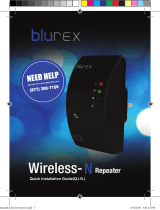
© Copyright 2013 TRENDnet. All Rights Reserved.
TRENDnet User’s Guide
Table of Contents
i
Table of Contents
Product Overview ........................................................................... 1
Package Contents .......................................................................................................... 1
Features ......................................................................................................................... 1
Product Hardware Features........................................................................................... 2
Application Diagram ...................................................................................................... 4
Basic Router Setup .......................................................................... 4
Creating a Home Network ............................................................................................. 4
Router Installation ......................................................................................................... 5
Connect additional wired devices to your network ....................................................... 9
Wireless Networking and Security ................................................. 10
How to choose the type of security for your wireless network .................................. 10
Secure your wireless network ..................................................................................... 11
Connect wireless devices to your router ..................................................................... 13
Connect wireless devices using WPS ........................................................................... 13
Basic wireless settings ................................................................................................. 16
Guest Network ............................................................................................................. 17
Steps to improve wireless connectivity ....................................................................... 18
Advanced wireless settings .......................................................................................... 19
Access Control Filters .................................................................... 19
Access control basics ................................................................................................... 19
MAC Address Filters ........................................................................................... 19
Parental Control ................................................................................................. 20
Firewall Rules ..................................................................................................... 21
Advanced Router Setup ................................................................. 22
Access your router management page ........................................................................ 22
Change your router login password ............................................................................ 22
Change your device name ........................................................................................... 23
Manually configure your Internet connection ............................................................ 23
IPv6 Connection Settings ............................................................................................. 24
Clone a MAC address ................................................................................................... 24
Change your router IP address .................................................................................... 25
Change your device URL .............................................................................................. 25
Enable DNS relay on your router ................................................................................. 25
Change your local domain name ................................................................................. 26
Set up the DHCP server on your router ....................................................................... 26
Set up DHCP reservation ............................................................................................. 27
Enable/disable UPnP on your router ........................................................................... 28
Enable/disable Application Layer Gateways (ALG) ...................................................... 28
Allow/deny multicast streaming.................................................................................. 29
Identify your network on the Internet ........................................................................ 29
Set your router date and time ..................................................................................... 30
Create schedules ......................................................................................................... 31
Open a device on your network to the Internet .......................................................... 31
DMZ ................................................................................................................... 31
Virtual Server ..................................................................................................... 32
Port Forwarding ................................................................................................. 33
Application Rules ............................................................................................... 33
Inbound Filter .................................................................................................... 34
Allow remote access to your router management page ............................................. 35
Set Internet bandwidth ............................................................................................... 35
Add static routes to your router .................................................................................. 36
Using External USB Storage ........................................................... 36
Samba Network File Server ......................................................................................... 36
Router Maintenance & Monitoring ............................................... 37





















